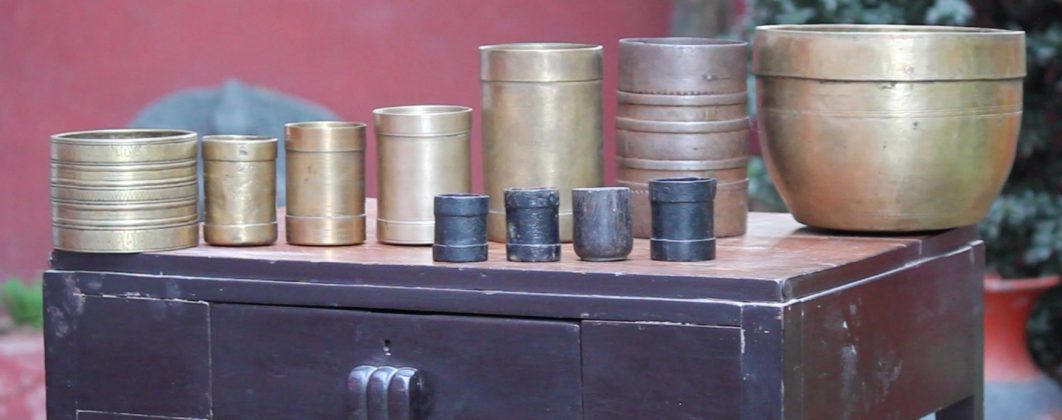
Before the introduction of Metric System, Indian states had their own indigenous measuring systems in place. When I was a child, we used measuring cups in our house. I distinctly remember my mother using them. With time, they were replaced with modern ones in my house and that’s the last I saw them.
After many years, I saw two of these vintage measuring cups in an antique shop. This was the time when I just started collecting antiques. I instantly decided to acquire them. As the years went by, I started collecting more of these during my travels and hunt for traditional antiques. As of today, there is no trace of these measuring cups in any urban household. I’m not sure if any of these are still used in the villages. My elder sister who is about eighty one years old still uses the tavva measuring cup (made out of bamboo) in her house in Kakinada. I’ve also had friends tell me that some Tamil households still use the padi.
So here’s a short video on vintage measuring cups that I have in my collection. If you have any stories or memories about measuring cups, do share. It would be wonderful and worthwhile to have some concrete information about these humble measuring cups that could be passed on to those (the future generations) who would want to know about them.

Copyright © 2021 YK Antiques Home Museum
3 Responses
Hello sir…I felt so happy to come across your blog… I always loved traditional ways of cooking… and also brass,bronze,stone cookware.. I use the same at home but there is no one to guide us properly about what should be cooked in what type of cookware.. I bought most of them from zista.. varishta tried her best to explain about these cookware…still I feel I need to here it from elderly people who have used them in their daily life…so my doubts are here sir… 1. Can we cook in brass without kalai being done.. ??
2.can we boil milk in bronze?? And also make rice??
3.i am scared to use kalchatti thinking that it might break..lack of knowledge about all this make me less confidence..and my mother is not interested in all this.. they think I am mad.. I am really looking for complete knowledge on this.. it would be great if can give us info about this topic” what should and shouldn’t be cooked in all these traditional cookware ” .. and also videos are missing in your blogs about idli patta and few more .. 🙂 such a happiness to go through your blogs sir.. thank you so much for all your information:)
Hello. Thank you for visiting our blog and writing to us. Nice to know that you too have a keen interest in traditional ways of cooking using brass, bronze and stone cookware.
Here are responses to your queries:
1. Can we cook in brass without kalai being done?
Yes, you can cook all food items in brass vessels except the ones where you use tamarind, lime, vinegar, raw mango and similar tangy foods. The tangy/sour foods will react with the metal and alter the composition of the food and this may not agree with the human body system. Any food not containing these tangy ingredients can be happily cooked in brass vessels. To be specific, you can not cook sambar, rasam and Andhra pulusu in a brass vessel. All other foods like rice, pongal, payasam, curries, masala curries, sweets etc can be cooked in brass vessels.
2. Can we boil milk in bronze? And also make rice?
Yes, you can boil milk in bronze and also make rice. Milk tastes so good when boiled in bronze.You can also use bronze to make all milk-based sweets.Bronze is meant for cooking rice and all rice related dishes like pongal etc. It is a tradition in Tamil Nadu that on the day of Pongal festival, rice is traditionally cooked only in vengala panai (bronze vessel). Rice and bronze is an excellent combination.
3. I am scared to use kalchatti thinking that it might break.
Initially, you have to season the kalchatti. Hope you have done the seasoning as advised by Zishta. Once it is seasoned, you need not have to worry about breaking.
Please follow these precautions:
Kalchatti has to go on to the fire with at least 1/4 th of any liquid, preferably half filled in.
We should understand that stone is not like metal. Stone is porous and in the minute pores, moisture or air or both are present.
When the stone pot is heated, the moisture or air trapped in the pores expand. If the temperature reaches the entire stone cooking pot evenly, then the pores will also expand uniformly and the stone cooking pot is intact.
If only partial heat is there on the surface and the rest of the pot is at room temperature, the heated part would only expand and the non-heated area remains as it is. This imbalance in the temperature on the surface of the pot creates cracks.
In your case, the tadka temperature will be mostly at the bottom and the rest of the area will be at normal temperature. It may result in cracks.
It is worth taking the trouble of these minimum precautions as the food cooked in kalchatti is divine.
As required by you, l love to share all that I know about cooking in traditional vessels. But the problem is that with so much to share, sometimes I do not know where to start and where to end. It is a subject by itself.
You can write to us at ykantiques@gmail.com and we will try and address all your queries.
As an elderly person ,I can clearly read the herculean magnitude efforts needed to pursue this hobby .
Providing insight into art & cultural habits of our ancestors , explaining the logic and basic scientific background of these articles of daily use ,the health upkeep in using these antique utensils and many such noble aspects of life